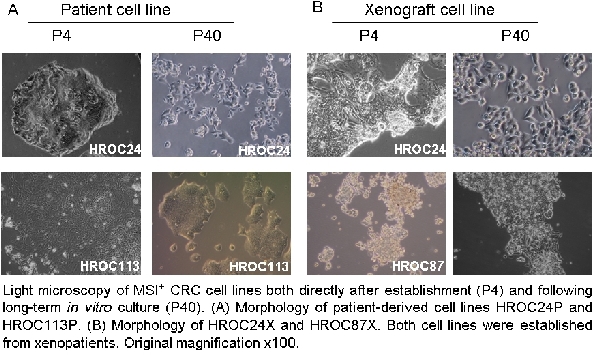|
Back to Annual Meeting Program
Establishment and Characterization of Three Microsatellite-Instable Cell Lines Derived From Sporadic and Inherited Primary Colorectal Carcinomas
Claudia Maletzki1, Ernst Klar1, Friedrich Prall2, Michael Linnebacher*1
1General Surgery, University of Rostock, Rostock, Germany; 2Institute of Pathology, University of Rostock, Rostock, Germany
Background: Microsatellite instability (MSI) is detected in about 15 % of all colorectal cancers (CRC). In order to identify new biomarkers that potentially allow for evaluating the response to new cytostatic drugs, pre-clinical in vitro models are mandatory. We here describe the successful establishment and comprehensive characterization of three patient-derived MSI+ cell lines along with their corresponding xenografts.
Methods: Three primary CRC cell lines (HROC24, HROC87, and HROC113) were established from a total of ten clinicopathological well defined MSI+ cases. Cells were comprehensively characterized by phenotype, morphology, growth kinetics and molecular profile. Subsequently, the response to clinically relevant chemotherapeutics was examined in vitro and in vivo.
Results: Two of the MSI+ cell lines derived from sporadic CRC showing CIMP-H (HROC24: APCmut p53wt, K-raswt, B-rafmut, HROC87: APCwt p53mut, K-raswt, B-rafmut), whereas one cell line (HROC113: APCwt p53wt, K-rasmut, B-rafwt) was HNPCC-associated. All cell lines were characterized as epithelial (EpCAM+, CEACAM+) tumor cells secreting different levels of cytokines. Response to chemotherapeutics was different between cell lines when analyzing in vitro and in vivo. Generally, the HNPCC-derived HROC113P cells tended to be more resistant than the sporadic MSI+ lines in vitro. However, when tested in nude mice, most pronounced effects were observed for HROC113P, especially following gemcitabine treatment. In those experiments, complete remission was obtained in 4/7 cases. Response to other drugs was again individual between xenografted cells.
Conclusion: Here, we describe the successful establishment of three new MSI+ CRC cell lines. These well-characterized and low-passage lines provide a useful tool for subsequent investigating the biological characteristics of MSI+ CRCs, both of sporadic and hereditary origin. Additionally, matched EBV-transformed B cell lines are available for comparative genetic studies.

Morphology of established MSI+ cell lines
Back to Annual Meeting Program
|


